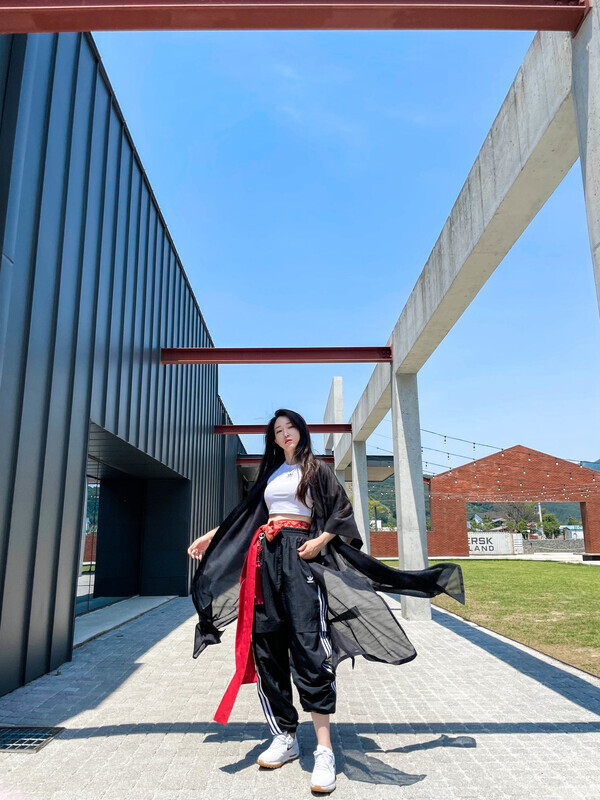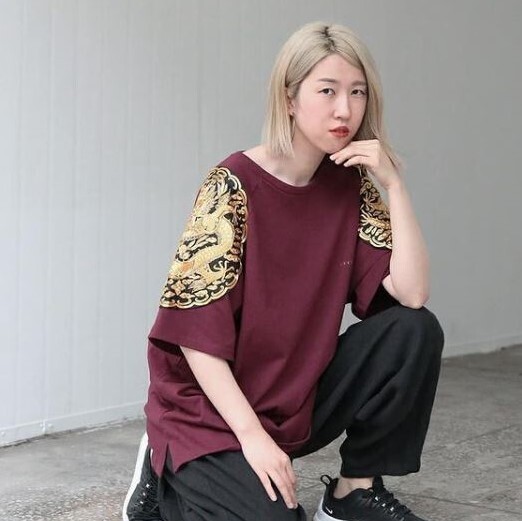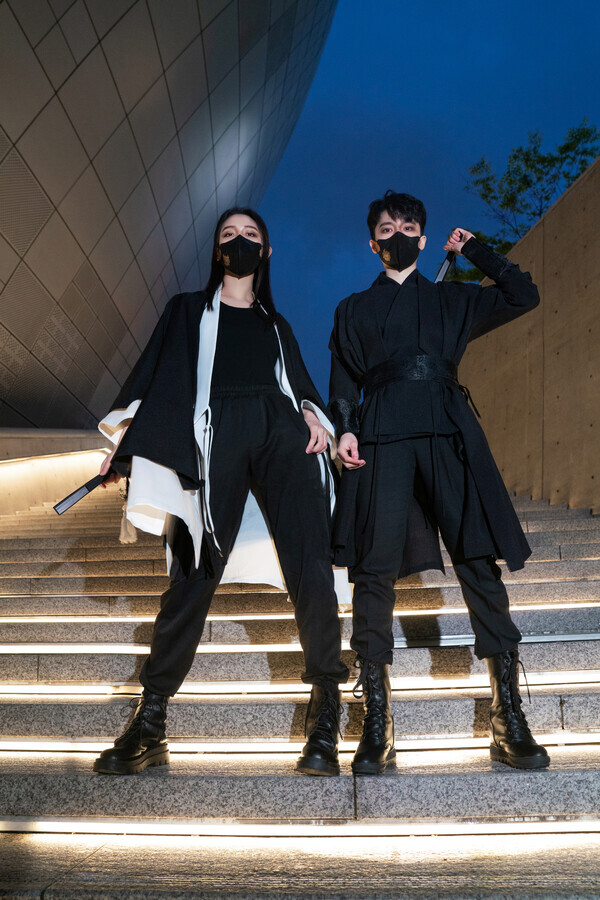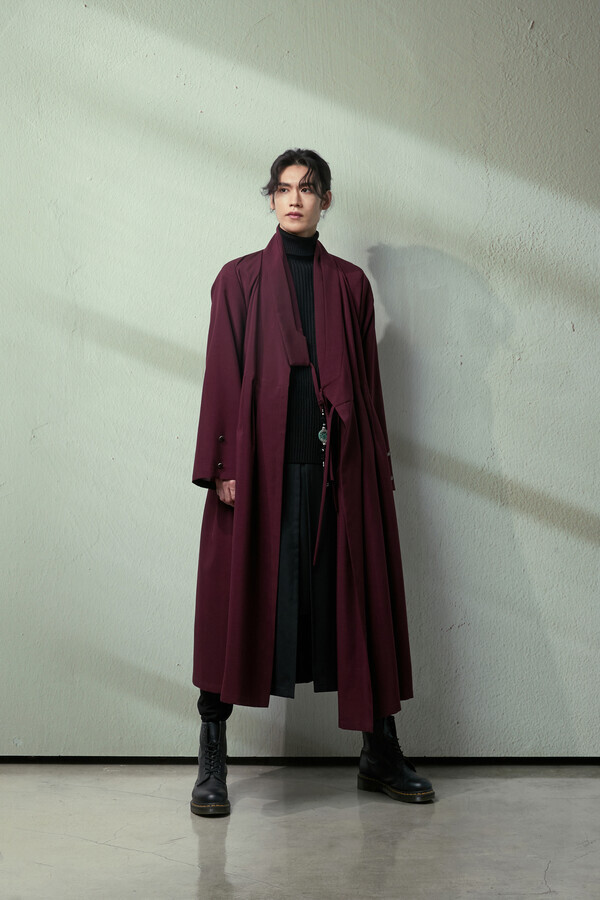hankyoreh
Links to other country sites 다른 나라 사이트 링크
Hanbok is evolving amid controversy

Hanbok, or traditional Korean clothing, has found itself at the center of a controversy.
Recently, Chinese internet users have begun picking fights with growing frequency, claiming that hanbok is a “fake” copy of Chinese garments. To put the best possible spin on it, this means that people are paying that much more attention to hanbok.
There’s also been a heated debate in Korea over modernized hanbok. People have been divided over whether such styles are “real hanbok.”
Amid all this arguing and transformation, a question arises: how much do we actually know about hanbok? Is there a confident reply we can give if we’re asked to define what hanbok is?
And what is the attitude of the people who actually make hanbok? We talked about the present and future of hanbok with two designers who are bringing today’s styles into the future based on their philosophies: Leesle Hwang of Leesle and Cho Young-ki of CheongUi MuBong.

Turn on a home shopping network and you’ll hear the same expression over and over: “You can just throw it on, and it will look fabulous.” It’s meant to refer to the kind of clothing you can casually wear at any time or place — but it’s also a somewhat strange thing to say about hanbok.
“Whenever I’ve designed ‘everyday hanbok’ that can be worn in ordinary situations, I’ve gotten the same question time and time again: ‘When do you actually wear this?’” Hwang said.
“I sensed there was a need for images to show concrete situations,” she added.
Such was the case for Gogori, a Goguryeo style-themed loungewear line presented in April 2021 by her modern hanbok brand Leesle. The “concreteness” meant images showing people playing board games with friends, holding their shopping basket at the supermarket, walking a dog in the park, or accepting a delivery.
For Leesle Hwang, it was the “experience” of hanbok that led her to her 2006 opening of an online shopping mall for hanbok dresses in 2006 — while still a student at 20 years of age — and her 2014 launch of Leesle, which has now established itself of one of Korea’s top three modern hanbok brands.
Hwang’s experience in 2011 with the “Wear Hanbok 100 Times Project” was the starting point for Leesle, which was meant to improve aspects such as wearing methods, laundering, price, and accessibility for interested consumers. The recent “Wearing Hanbok Project” includes 1,000 different activities that can be done in hanbok, with examples such as pop concert attendance and bowling shared on social network services.
As someone who has spent a lot of time both using hanbok and planning and developing hanbok-related culture, Hwang is acutely aware of changes in the way people view the wearing of hanbok.
“Back when I was doing the ‘Wear Hanbok 100 Times,’ a lot of people asked me whether I was a ‘shaman’ or a ‘traditional Korean musician,’” she recalled.
“They meant that there had to be some specific reason I was wearing hanbok. These days, the same people who used to cluck their tongues back when I launched Leesle in 2014 over me wearing hanbok with sneakers and my hair dyed red, or wearing sunglasses with a dopo [traditional overcoat], are now accepting that as ‘the style,’” she added.

The sapok slacks worn by Jimin during a 2018 Melon Music Awards by BTS — considered one of the group’s best-ever performances — are a hanbok item designed as unisex. Hwang noted a wider scope of change in the genderless styles that have been a pronounced trend in recent hanbok.
“Fashion today has blurred distinctions of gender and age. The trend is one where beauty standards and boundaries of ethnicity and country are disappearing, and I see the post-COVID era as that kind of transcendent era,” she said.
“Hanbok has also been keeping step with that. I had the increased amount of time we spend indoors in mind when I designed the hanbok loungewear,” she said.
The elements that Koreans ordinarily associate with hanbok are mostly designs from the late Joseon era. Styles that break from that approach — with the style of the collar or the way it is adjusted — have even Koreans questioning whether they are “really hanbok”; some suggest that it looks “Chinese” instead, or that it borrows from the Japanese kimono or jinbei.
“People may view it as ‘not Korean’ because they aren’t accustomed to it. In cases like that, it’s the designer’s job to demonstrate for them with the clothing,” Hwang said.
“Often, when one of the Chinese internet users tries to pick a fight in the replies, I’ll just quietly click on the ‘report’ button,” she added, drawing laughs from the listeners. Her message was that they can envy hanbok all they want; Koreans should just continue wearing them.
Leesle recently became the first hanbok company to partner with the SPA (specialty retailer of private label apparel) brand SPAO. Leesle supervised the design and held discussions to boost the quality of the final product.
“Experiencing modern hanbok can lead people to traditional hanbok,” Hwang noted. “If we want that to happen, then quality is crucial. If the clothing falls apart after just a few washes, that’s not going to need them to the next stage of experience.”
One matter does remain to be addressed: the relatively steep price. Hwang aims to pursue partnerships in different areas to broaden the base of interest in hanbok, while hand-making outfits in more modestly priced ranges and helping to establish hanbok as a fashion genre in its own right.

The name CheonUi MuBong comes from an expression that literally means “the clothing of heaven has no stitch marks.” It is used to express when something is flawless.
Living up to that name would seem like a heavy burden for a designer to take on. When asked about it, designer Cho Young-ki laughed and nodded his head.
“It was an entirely wrong name for a clothing maker. Even the slightest mistake and you’re in for it,” he said.
“At the company, we jokingly use the name JiHa YuBong [‘these are the kinds of stitches you’ll find here on earth’]. But since I studied hanbok under a master of hand-quilting after graduating from the clothing department, I can’t be careless about anything.”
Cho was given the working name “Uibong,” which was meant to urge him to work toward achieving the kind of seamlessness the CheonUi MuBong name connotes. He continues to this day bearing the weight of the title he chose when he created his brand in 2003.
The hanbok of today cut an even more impressive figure when presented in dynamic settings. In the past, musicians had typically only worn hanbok on special holiday broadcasts; after the BTS performance at the Melon Music Awards in 2018, they became more frequently adopted as performance outfits for K-pop artists.

Cho recalled the Melon performance as a breathtaking moment where the qualities of hanbok truly stood out — particularly the way the lines of the garments flow with the movements of dancing.
“With hanbok, you have elements of lines and flow. The sochangui [a form of coat with side slits] that J-Hope wore for his barefoot dance had those strong points in mind, and it was just so beautiful to see the way the tail rippled,” he said.
“The qualities of clothing truly perform their role to the fullest when it comes together with a great artist,” he added.
“The styling was also very well done. It was a mix of new hanbok style with modern clothing, and it came together perfectly, like the north and south poles of a magnet meeting.”
As media borders have faded away, the hanbok styles that appear in Korean popular culture have attracted global attention more or less in real time. At the same time, claims of “ownership” by Chinese internet users have grown more and more frequent.
Cho himself has seen internet posts labeling his designs as “fake.”
“For example, flat composition in clothing isn’t just something they use in Korea, China, and Japan. You’ll find it throughout Eurasia,” he said..
“The reason has to do with the very first principles of making clothing. Everyone developed designs that were suited to their country,” he added.
“What they’re doing now is gathering examples of things that look ‘similar’ to their eyes and calling them ‘copies.’ But the ‘originals’ they’re citing aren’t even their own. They’re calling the cheollik [military coat] ‘Chinese,’ but it’s Mongolian. It’s exasperating to see the kinds of absurd arguments they make.”

Clothing develops as neighboring countries exchange influences, forming new strands in different cultures. This means that when people ignore that aspect and argue exclusive “ownership,” they fall into a trap of logically attacking themselves.
“When you talk about ‘modern hanbok,’ people still have this image of modified designs, where they only think of it in terms of simplifying or getting rid of the cumbersome old methods. But the new hanbok by CheonUi MuBong is an example of taking old forms of clothing and designing them in a way that makes them seem appealing even today,” Cho said.
“If you look at it just in terms of convenience, you may not need things like the goreum [a ribbon for fastening the top] or the strings,” he added. “But I decided not to get rid of those. They’re forms that I used because I thought I should incorporate them, even if they make it a bit difficult to put on.”
In fashion, you find forms and decorative elements that have been kept even when their original function and meaning has fallen by the wayside. People today choose to wear them for one reason only: they still look good.
In Western clothing, order has been made from those forms, and the names of different styles remain in use today. With designers today producing all sorts of different creations inspired by traditional Korean clothing, Cho Young-ki says that the future of hanbok will be one where the competition decides the fate of new styles for consumers — and the designs that survive will be the styles of tomorrow.
By Yoo Seon-joo, contributing writer
Please direct comments or questions to [english@hani.co.kr]

Editorial・opinion
![[Editorial] Penalties for airing allegations against Korea’s first lady endanger free press [Editorial] Penalties for airing allegations against Korea’s first lady endanger free press](https://flexible.img.hani.co.kr/flexible/normal/500/300/imgdb/original/2024/0502/1817146398095106.jpg) [Editorial] Penalties for airing allegations against Korea’s first lady endanger free press
[Editorial] Penalties for airing allegations against Korea’s first lady endanger free press![[Editorial] Yoon must halt procurement of SM-3 interceptor missiles [Editorial] Yoon must halt procurement of SM-3 interceptor missiles](https://flexible.img.hani.co.kr/flexible/normal/500/300/imgdb/child/2024/0501/17145495551605_1717145495195344.jpg) [Editorial] Yoon must halt procurement of SM-3 interceptor missiles
[Editorial] Yoon must halt procurement of SM-3 interceptor missiles- [Guest essay] Maybe Korea’s rapid population decline is an opportunity, not a crisis
- [Column] Can Yoon steer diplomacy with Russia, China back on track?
- [Column] Season 2 of special prosecutor probe may be coming to Korea soon
- [Column] Park Geun-hye déjà vu in Yoon Suk-yeol
- [Editorial] New weight of N. Korea’s nuclear threats makes dialogue all the more urgent
- [Guest essay] The real reason Korea’s new right wants to dub Rhee a founding father
- [Column] ‘Choson’: Is it time we start referring to N. Korea in its own terms?
- [Editorial] Japan’s rewriting of history with Korea has gone too far
Most viewed articles
- 1[Editorial] Penalties for airing allegations against Korea’s first lady endanger free press
- 260% of young Koreans see no need to have kids after marriage
- 3Months and months of overdue wages are pushing migrant workers in Korea into debt
- 4Bills for Itaewon crush inquiry, special counsel probe into Marine’s death pass National Assembly
- 5Historic court ruling recognizes Korean state culpability for massacre in Vietnam
- 6In rejecting statute of limitations defense in massacre case, Korean court faces up to Vietnam War a
- 7“Those souls can rest now”: Vietnam massacre survivor reacts to Korean court win
- 8[Reporter’s notebook] In Min’s world, she’s the artist — and NewJeans is her art
- 91 in 3 S. Korean security experts support nuclear armament, CSIS finds
- 10[Editorial] Yoon must halt procurement of SM-3 interceptor missiles